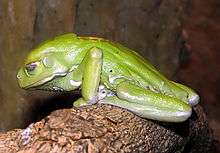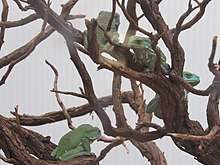Phyllomedusa sauvagii
Phyllomedusa sauvagii, commonly known as the waxy monkey tree frog,[2] is a species of frog in the family Phyllomedusidae. It is native to South America, where it occurs in Argentina, Bolivia, Paraguay and Brazil.[1]
| Phyllomedusa sauvagii | |
|---|---|
 | |
| Scientific classification | |
| Kingdom: | Animalia |
| Phylum: | Chordata |
| Class: | Amphibia |
| Order: | Anura |
| Family: | Phyllomedusidae |
| Genus: | Phyllomedusa |
| Species: | P. sauvagii |
| Binomial name | |
| Phyllomedusa sauvagii Boulenger, 1882 | |
This species is arboreal, living in the vegetation of the Gran Chaco. It breeds during the rainy season.[1] It lays eggs along the middle of a leaf blade and folds the leaf, sandwiching the eggs inside. Its nest is attached to a branch suspended over a stream, so the hatching tadpoles drop into the water.[3]

As in other species in the family of leaf frogs, it has physiological and behavioural adaptations to limit water loss, including reducing water loss through the skin by lipid secretions, excretion of uric acid (uricotelism), and diurnal torpor.[4] Lipid secretions are produced in a special type of cutaneous gland, and are spread over the surface of the skin by the legs in a complex sequence of wiping movements.
The frogs generate many different pharmacologically active peptides as part of the defensive secretions covering their skin. Several of these peptides have found scientific uses as research ligands, including the opioid peptide dermorphin.[2]
References
- Aquino, L, et al. 2004. Phyllomedusa sauvagii. The IUCN Red List of Threatened Species 2004. Downloaded on 21 January 2018.
- Bogdanich, W. and R. R. Ruiz. Turning to Frogs for Illegal Aid in Horse Races. New York Times 19 June 2012.
- Frazer, J.F.D. (1973) Amphibians. Wykeham Publications, London, pp.75.
- Blaylock, L. A., Ruibal, R. and Platt-Aloia, K. (1976) Skin structure and wiping behavior of Phyllomedusinae frogs. Copeia, 1976: 283–295.
External links


